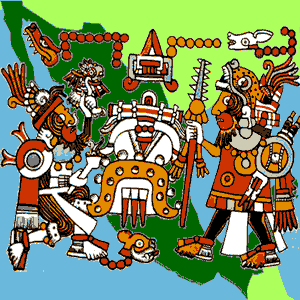 COM.on C.A.2:e9/56-61
Online published on Dec.
9, 2008.
COM.on C.A.2:e9/56-61
Online published on Dec.
9, 2008.doi:10.4236/coca.2008.21009
REPORT Editors’ Pick from the American Society of Human Genetics 58th Annual Meeting. Philadelphia, Pennsylvania, Nov. 11-15, 2008
 COM.on C.A.2:e9/56-61
Online published on Dec.
9, 2008.
COM.on C.A.2:e9/56-61
Online published on Dec.
9, 2008.Chinese translator:
ZHANG Yifan,
Center for Vascular Biology, University of
Connecticut Health Center,
Farmington,CT06030 USA
ABSTRACT:
With more than 180 ethnic and linguistics
groups, Mexico is a rich source for
anthropological and population studies. This
country witnessed the rise and fall of major
civilizations, including the well-known Maya
and Aztec civilizations, but as a result of
heavy European colonization and influx, the
population landscape has dramatically
changed over the past five centuries. Today
less than 30% of modern Mexicans identify
themselves as being fully or partly
Amerindians and the remaining population
seems to have very little in common with
their pre-Columbian ancestors. However, this
is not the case when the maternal genetic
component is evaluated in detail. Analysis
of the mitochondrial DNA (mtDNA) control
region sequences, including HVS-I, HVS-II
and HVS-III, from more than 2,000 subjects
revealed an overwhelming Native American
legacy in the modern Mexican population,
with ~90% of mtDNAs belonging to the four
major pan-American haplogroups A2, B2, C1
and D1. This finding supports a European
contribution to the Mexican gene pool
primarily by male settlers and confirms the
effectiveness of employing the uniparentally-transmitted
mtDNA as a tool to reconstruct a country’s
history.
Agreement was received from the authors to translate this paper into Chinese.
Recieved: Nov.26,2008 Accepted: Dec.9,2008 Corresponding: Ugo@SMGF.org
现代墨西哥线粒体DNA多样性分布概况
安智利·莱山渡1,2, 北宫·武国2,3, 龚-帕米尔·艾佳3, 希达-佛乐·瑞卡4, 瑞奇·可缇3, 胡奇·罗布3, 安霍·诺曼3, 多灵·安东2, 麦思·纳达3, 梧沃·苏格3
1. 佩鲁贾大学环境和细胞生物学系,意大利 佩鲁贾06100; 2. 帕维亚大学遗传学与微生物学系,意大利 帕维亚27100; 3. 索伦森分子家谱基金会,美国 犹他州 盐湖城84115; 4. 墨西哥社会安全研究所东北生物医学研究研究中心遗传学组,墨西哥 新莱昂州 蒙特雷 64720
翻译: 张一帆,康奈狄格大学健康中心血管生物学中心,美国 康州 垡明屯 06030
摘要:拥有超过180个语言民族群体的墨西哥是人类学和群体研究的丰富资源。这个国家见证了包括著名的玛雅文明和阿兹台克文明在内的重大文明的兴起和衰亡。但是由于欧洲的大规模殖民涌入,其人口概况在过去的五个世纪里发生了剧烈的变化。今天不到30%的现代墨西哥人自我认同为完全或者部分美洲印地安人, 而其余的人群却似乎与他们在哥伦布时代之前的祖先鲜有共同之处。但是,在仔细研究了母系遗传成分之后,我们发现事实并非如此。通过对来自两千多个样本的线粒体DNA调控区序列(包括HVS-1、HVS-II、HVS-III)的分析,我们发现了现代墨西哥人群中存在着极大的美洲原住民痕迹。现代墨西哥人中,90%的线粒体DNA属于四个主要的泛美洲单倍群(A2、B2、C1、D1)。这个发现不仅支持欧洲人对墨西哥基因库的贡献主要是通过男性殖民者的学说,还证实了采用单亲传递的线粒体DNA来重构一个国家历史这个方法的有效性。
收稿日期:2008年11月26日 修回日期:2008年12月9日 联系人:北宫武国Ugo@SMGF.org
1. Cotterell AF (1986) A dictionary of world mythology. Oxford, UK: Oxford University Press.
2. Lisker R, Ramirez E, Briceño RP, Granados J, Babinsky V (1990) Gene frequencies and admixture estimates in four Mexican urban centers. Hum Biol 62:791-801.
3. Schurr TG, Ballinger SW, Gan YY, Hodge JA, Merriwether DA, Lawrence DN, Knowler WC, Weiss KM, Wallace DC (1990) Amerindian mitochondrial DNAs have rare Asian mutations at high frequencies, suggesting they derived from four primary maternal lineages. Am J Hum Genet 46:613-623.
4. Torroni A, Chen YS, Semino O, Santachiara-Beneceretti AS, Scott CR, Lott MT, Winter M, Wallace DC (1994) mtDNA and Y-chromosome polymorphisms in four Native American populations from southern Mexico. Am J Hum Genet 54:303-318.
5. Buentello-Malo L, Peñaloza-Espinosa RI, Loeza F, Salamanca-Gomez F, Cerda-Flores RM (2003) Genetic structure of seven Mexican indigenous populations based on five polymarker loci. Am J Hum Biol 15:23-28.
7. Cerda-Flores RM, Budowle B, Jin L, Barton SA, Deka R, Chakraborty R (2002) Maximum likelihood estimates of admixture in Northeastern Mexico using 13 short tandem repeat loci. Am J Hum Biol 14:429-439.
8. Cerda-Flores RM, Villalobos-Torres MC, Barrera-Saldaña HA, Cortés-Prieto LM, Barajas LO, Rivas F, Carracedo A, Zhong Y, Barton SA, Chakraborty R (2002) Genetic admixture in three Mexican Mestizo populations based on D1S80 and HLA-DQA1 loci. Am J Hum Biol 14:257-263.
9. Peñaloza-Espinosa RI, Arenas-Aranda D, Cerda-Flores RM, Buentello-Malo L, González-Valencia G, Torres J, Alvarez B, Mendoza I, Flores M, Sandoval L, Loeza F, Ramos I, Muñoz L, Salamanca F (2007) Characterization of mtDNA haplogroups in 14 Mexican indigenous populations. Hum Biol 79:313-320.
10. Andrews RM, Kubacka I, Chinnery PF, Lightowlers RN, Turnbull DM, Howell N (1999) Reanalysis and revision of the Cambridge reference sequence for human mitochondrial DNA. Nat Genet 23:147.
11. Achilli A, Perego UA, Bravi CM, Coble MD, Kong QP, Woodward SR, Salas A, Torroni A, Bandelt HJ (2008) The phylogeny of the four pan-American MtDNA haplogroups: implications for evolutionary and disease studies. PLoS ONE 3:e1764.
12. Brown MD, Hosseini SH, Torroni A, Bandelt HJ, Allen JC, Schurr TG, Scozzari R, Cruciani F, Wallace DC (1998) mtDNA haplogroup X: An ancient link between Europe/Western Asia and North America? Am J Hum Genet 63:1852-1861.
13. Tamm E, Kivisild T, Reidla M, Metspalu M, Smith DG, Mulligan CJ, Bravi CM, Rickards O, Martinez-Labarga C, Khusnutdinova EK, Fedorova SA, Golubenko MV, Stepanov VA, Gubina MA, Zhadanov SI, Ossipova LP, Damba L, Voevoda MI, Dipierri JE, Villems R, Malhi RS (2007) Beringian standstill and spread of Native American founders. PLoS ONE 2:e829.
14. Torroni A, Schurr TG, Cabell MF, Brown MD, Neel JV, Larsen M, Smith DG, Vullo CM, Wallace DC (1993) Asian affinities and continental radiation of the four founding Native American mtDNAs. Am J Hum Genet 53:563-590.
15. Torroni A, Huoponen K, Francalacci P, Petrozzi M, Morelli L, Scozzari R, Obinu D, Savontaus ML, Wallace DC (1996) Classification of European mtDNAs from an analysis of three European populations. Genetics 144:1835-1850.
17. Palanichamy MG, Sun C, Agrawal S, Bandelt HJ, Kong QP, Khan F, Wang CY, Chaudhuri TK, Palla V, Zhang YP (2004) Phylogeny of mitochondrial DNA macrohaplogroup N in India, based on complete sequencing: implications for the peopling of South Asia. Am J Hum Genet 75:966-978.
18. Behar DM, Villems R, Soodyall H, Blue-Smith J, Pereira L, Metspalu E, Scozzari R, Makkan H, Tzur S, Comas D, Bertranpetit J, Quintana-Murci L, Tyler-Smith C, Wells RS, Rosset S; Genographic Consortium (2008) The dawn of human matrilineal diversity. Am J Hum Genet 82:1130-1140.
19. Kong QP, Bandelt HJ, Sun C, Yao YG, Salas A, Achilli A, Wang CY, Zhong L, Zhu CL, Wu SF, Torroni A, Zhang YP (2006) Updating the East Asian mtDNA phylogeny: a prerequisite for the identification of pathogenic mutations. Hum Mol Genet 15:2076-2086.
20. Fagundes NJ, Kanitz R, Eckert R, Valls AC, Bogo MR, Salzano FM, Smith DG, Silva WA Jr, Zago MA, Ribeiro-dos-Santos AK, Santos SE, Petzl-Erler ML, Bonatto SL (2008) Mitochondrial population genomics supports a single pre-Clovis origin with a coastal route for the peopling of the Americas. Am J Hum Genet 82:583-592.